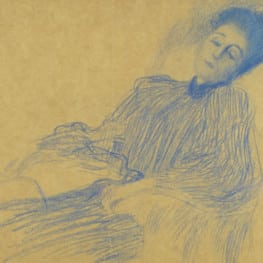Gustav Klimt
1862-1918
Whether his subjects were awake or dozing, women fascinated the Austrian artist Gustav Klimt. The female figure dominated Klimt’s oeuvre, persisting as a life-long focus of his drawings and paintings. Klimt was a controversial figure, challenging the aesthetic establishment early on in his career with radical themes. The artist’s paintings, murals and drawings reflect ‘the Viennese fin de siècle’ influences of the Symbolist and Art Nouveau movements.
Born in a suburb outside of Vienna, Klimt moved to the capital to study drawing and trained as an architectural painter. He was a superb draughtsman as evidenced in the initial commissions he received to paint interior murals and ceilings. Klimt accepted his last public commission in 1894, after his paintings for the ceiling of the Great Hall of the University of Vienna were rejected by his patrons and the public. Three years later Klimt was leading an aesthetic revolution — breaking with the prevailing tenets of the Kunstlerhaus and forming a new art association. The group became known as Vienna Secession.

